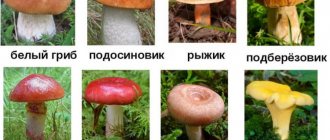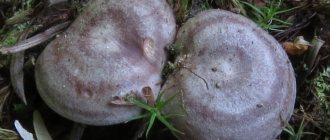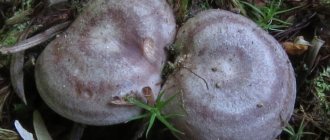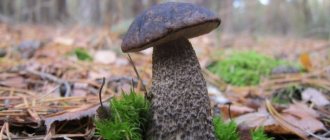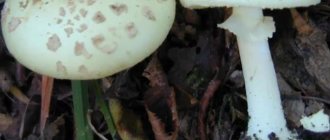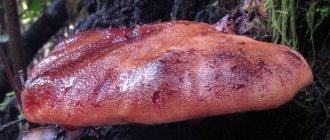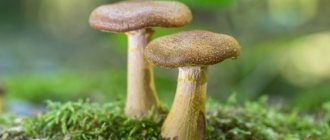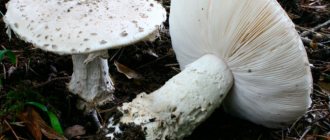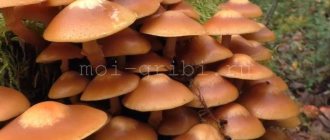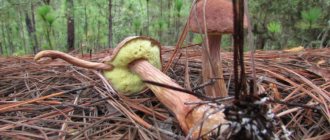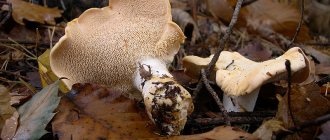The mushrooms, which can be found growing on and under trees, have a strong smell. They are incredibly tasty compared to regular or steppe ones. For example, winter honey fungus and autumn oyster mushroom are quite common in central Russia. They will be a wonderful decoration for the holiday table. However, there are mushrooms that are not edible. They can cause poisoning and even death. In the following blocks all types of mushrooms will be considered.
Mushrooms on poplars. The illustration for the article is used from the site grib22.ru
Edible mushrooms growing on poplar trees
Of all the mushrooms that grow directly on poplars, the safest is oyster mushroom, since it has no poisonous counterparts. But with the rest you need to be careful.
Autumn oyster mushroom
Found in the forest from September to October. It grows directly on a poplar trunk, stump or dead part of a tree in a group, often fused with short, curved cylindrical stalks. In some cases, the leg is missing. The length is about 3 centimeters and the width is up to 4. In addition, the leg has a dense structure, covered with small scales, often colored in yellow, brown and greenish shades.
The autumn oyster mushroom cap grows sideways and has an oblong-lingual or ear-shaped shape, with a diameter of about 8 centimeters, and sometimes up to 15 centimeters. The cap of the oyster mushroom is fleshy, with descending white plates. Depending on age, the color also changes from gray to gray-brown or ocher. The pulp is white and has no pronounced odor.
Oyster mushrooms are harvested at a young age. The advantage of this mushroom is that it is not damaged by parasites and has a rich mushroom aroma. It is distinguished from other inedible mushrooms by the non-leathery and fleshy structure of the cap pulp.
Winter honey fungus
This winter mushroom appears in late autumn and early winter, sometimes even at the end of December. Can grow under snow. Outwardly, it is similar to the summer one, the difference lies in the presence of a leg with scales and a ring, as well as a cap that is dry to the touch. The color of the stem of the winter mushroom is dark brown or black. Closer to the top it acquires a yellow tint. The leg grows in length from 4 to 8 centimeters, and the average thickness is 0.5 cm.
The diameter of the winter mushroom's cap reaches 8 centimeters and has the shape of a dome (bell). The hat is covered with a sticky substance and can be reddish, orange, brown or ocher in color. The blades are wide and often spaced, white or light ocher in color.
Winter fly agaric grows in dense clusters not only in the forest, but also in parks and gardens, usually on the south side of the tree. Interestingly, it has no poisonous analogues. When preparing, it should be taken into account that honey mushrooms contain a certain amount of toxins and require boiling for at least 20 minutes. As a rule, this time is enough for their complete destruction.
Summer honey fungus or poplar
Summer agaric is harvested from June, and fruiting lasts in October. Summer honey mushrooms of autumn mushrooms are distinguished by their cap. Consequently, the cap of the summer mushroom is two-colored, darker in the center and lighter at the edges. The edges are damp. When the summer is dry, the cap of the summer mushroom dries out. Newly grown mushrooms have a yellowish-brown cap, while mature ones are dark orange and brown. Autumn mushrooms, unlike summer ones, do not have an aggressive color. They are characterized by pastel colors.
They do not differ in size and structure from those grown in winter. In addition, summer honey mushrooms have large quantities of brown spores.
A more poisonous analogue of the summer mushroom, galerina rim, grows only on coniferous trees. Therefore, you should not collect honey mushrooms near pines and spruce trees.
Sulfur-yellow tinder fungus
The sulfur-yellow Tinder mushroom is conditionally edible. This type is a multi-tiered wavy mass of a rounded and at the same time flat shape. The color of this species of tinder fungus is bright yellow. The surface of the fruiting body is covered with yellow fluff.
The diameter of the cap can reach 15 centimeters with a thickness of 5-8 centimeters. Some fruits reach 40 centimeters in diameter. The fruits of fused hats can weigh 10 kilograms. The color of the pulp is the same bright yellow. The bottom of the cap consists of short tubes. The young mushroom has a pleasant sour taste.
The Tinder mushroom grows on old or dead poplar wood, and sometimes on other deciduous trees. This is a parasite that destroys a tree due to its vital activity. The tinder fungus has an inedible counterpart - northern climacodon, which has a lighter color and characteristic protrusions - spines on the cap. In addition, the double has an unpleasant smell.
Sulfur-yellow polyps are used in salads, pickles and other dishes. Its peculiarity is that it needs to be cooked for 50-60 minutes. Polypore has medicinal properties, as it contains a certain amount of antibiotic substance. It is also believed to have the ability to boost immunity.
Variegated tinder fungus
Variegated (scaly) tinder fungus is also often found in nature. It is located at the bottom of the tree, sometimes at its base, has the shape of a funnel, and over time it levels out and becomes flat. The diameter of the cap can reach 50 centimeters.
Mushrooms on poplar stumps
Good evening, please judge us. Today in the forest, mushrooms were found on the stumps of cut down trees and on the trees themselves (poplars). We argue about suitability for food.
- Good evening. Most likely this is the destroying flake (Pholiota destruens) - an inedible mushroom due to its strong bitterness. It is not on the website, but you can look and compare it on the Internet: Search for photos of the mushroom as Pholiota populnea.
- Thank you! Is it actually possible to eat oyster mushrooms without looking back? There are so many of them growing on trees, but apparently they are not collected.
– There are no poisonous species among oyster mushrooms. (If you are sure that these are oyster mushrooms and not tinder fungi, for example) But one general rule applies to them: do not collect near roads, factories, landfills. since they absorb all the nasty things that are nearby and don’t take old ones that are outgrown.
The collected impressive volume of raw materials for Ivan tea or limited free time (sometimes all together) do not allow us to produce Koporye tea using traditional technology by hand. Modern means come to our aid, one of which is a simple electric meat grinder. Tea made using this method is granulated . (more details)
Already in the month of April, delicious, delicious spring mushrooms - morels - begin to grow en masse, represented by three main types: real morel, conical morel, cap morel. Next to morels you can often find giant and ordinary lines. For lovers of exotic dishes, the spring forest also offers beautiful sarcoscyphae, miniature strobilurus, and a wide variety of saucers. In May, the species composition increases significantly: various horned beetles, dung beetles, polypores, champignons, puffballs, May rows, entolomas, platies, and spring honey mushrooms are added.
Edible mushrooms of unusual shapes found in the territories of the European part of Russia, Belarus, Ukraine, Kazakhstan, and Germany have been added to the catalog:
| Grifola umbellata |
Descriptions with photos of the common liverwort (liver fungus) and sleeper mushroom (sawtooth scale) have been added to the catalog with edible mushrooms.
Few lovers of quiet hunting know that those edible mushrooms that grow under poplars and on these trees have a rich aroma and great taste. So, under this tree you can collect autumn oyster mushroom, winter, summer and poplar honey fungus, tinder fungus, poplar row, and other varieties and they will decorate any table. It is also worth paying attention to mushrooms that are unsuitable for food - they can also be found under poplar trees.
Reviews about poplar rowing
Our Ryadovsky poplar is almost the only mushroom that can be collected in large quantities. There are no forests, there are only fields around with the same windbreaks. Poplars were planted back then because they grow quickly. During the season, disadvantaged people go to all the meals. But it is best to treat it immediately after returning home. And you need large containers for soaking.
In our country they are dried, pickled and salted. It is not advisable to freeze because of the ground. This means you won't be able to remove it from the frozen row. After thawing, the fungal tissues become damaged and grow.
We wanted to walk along the poplar rows. You still need to eat something, but they were told they were very tasty. And you can type quickly and a lot. I don't know, maybe we did something wrong?
They printed a lot and quickly. But when they were cooked.. these mushrooms tasted very strange. Not bitterness, which was understood, but as if the soap was full. Aromatic seasoning. Well, maybe they didn’t make poplar at all, but some others did. Then it's good that we weren't poisoned.
Podtopolnik (Tricholoma populinum) is a conditionally edible mushroom from the family of ordinary mushrooms. It is not as popular as porcini mushrooms, porcini mushrooms and other trophies of “quiet hunting” lovers, but it is no less tasty.
Similar species
This representative has perfectly adapted to grow next to poplars in the autumn, which is why it can be easily distinguished from other mushrooms. However, young mushrooms have some similarities with the crowded row. The main difference is the large size of the poplar row and the bitter taste.
The row is crowded
Also, the poplar row has some similarities with the poisonous tiger row. They can be distinguished by two main characteristics: poplar row grows in groups and next to poplars.
What mushrooms can be found under poplars?
The most common poplars found in the fall are rowan, boletus and boletus.
Poplar row
A number of conditionally edible poplars at a young age have the shape of a hemisphere with thin curved edges. Over time, the mushroom cap straightens and becomes more voluminous. The poplar hat grows up to 12 centimeters in diameter.
There are often thin plates under the hood. The color of the dishes can be white or pinkish brown. The leg is fleshy with a scaly coating and has the shape of a cylinder. The color of the leg is white-pink or light brown. When the legs are squeezed, brown spots appear.
This species grows in deciduous forests, under poplars, and in dense thickets. The growing season of the poplar row is from August to the end of October. The row is often used to prepare various dishes. Before cooking, the mushrooms are thoroughly washed, soaked in water, and then boiled. This treatment allows you to get rid of unnecessary bitterness.
Gray boletus
The boletus has a hemispherical cap, with curved edges, up to 15 centimeters in size. The hat has a rough surface that is uneven to the touch. The color of the hat is gray or brown-gray.
The flesh of the mushroom is white, when cut, it acquires a pink tint and after a certain period of time becomes black. Boletus mushrooms have a pleasant aroma and taste.
The boletus leg reaches 14 centimeters and has a thickness of 4 centimeters. The upper leg is gray, the lower leg is brown. In addition, the leg is covered with white or yellowish-brown scales. Ripens from June to the end of October. It usually grows under birch trees, but is often found near poplar. Boletus mushrooms are suitable for preparing various dishes.
Milk mushrooms aspen and blue
The aspen (poplar) mushroom grows in dense clusters. A special feature is the presence of a large amount of white juice in it, which protects the fungus from parasites.
The mushroom has a funnel-shaped cap measuring approximately 14 centimeters. The hat is pink, soft and sticky to the touch. The plates are frequent, narrow, and extend from the cap to the stem. They have a white or pink tint. The leg is small, but very dense. Milk is more suitable for pickling due to its bitterness. It needs to be soaked for a long time in advance. Not suitable for drying.
Quite often in deciduous and mixed forests with high humidity, lactic honey mushrooms are found. It has a convex cap, which during development takes the shape of a funnel and is covered with small scales. Its color varies from yellow to intense yellow. With high humidity, the hood becomes sticky. The plates of this mushroom are slightly downward, thin, with a pale yellow tint.
The height of the leg of the blue weight is 4-10 centimeters, diameter is 3 centimeters, light yellow in color. When squeezed, the leg turns blue. Hence the name - blue milk mushroom.
The blue mushroom bears fruit from August to the end of November, before the onset of the first frost. The taste of mushrooms is bitter due to the presence of milk juice. For this reason, they need careful processing. The most suitable cooking method is pickling. Only young fruits are collected for food and immediately processed.
Sandstone mushroom. Gerbil mushrooms photo and description
- mushrooms that can be found in the forest only if you look closely.
After all, they are hiding under a hill of sand and pine needles. And if you dig up this mound, you will find a whole family. But we’ll figure it out further what to do with this find. Sandpipers are in the edible category. They can be pickled, fried, boiled, stewed and salted.
The only negative is that the soil in which they grow often stains them, so you need to carefully treat the product before use. But this process is worth the finished result - the dishes turn out tasty and aromatic.
The mushroom also has the following names: sandstone, poplar, poplar row, poplar and poplar.
At first it is convex in the middle and with the edges turned inward. As the hat grows, it straightens and bends inward. It is fleshy, and in high humidity or after rain it becomes slippery and acquires a light brown color. The diameter can reach 12 cm. The flesh of the cap is reddish.
They are frequent and thin. At first they are white and cream in color, and then, along with the cap, they begin to turn brown.
Small and thin - up to 7 cm. Color can vary from white to milky. The inside is solid and fleshy. There is a small scaly coating on the outside.
White, soft, fleshy, elastic. Under the skin it has a brownish tint, floury and bitter taste.
. The soil is sandy. The mushrooms got their name, poplar, precisely because of the place where they grow. They can be found near poplars and stumps. They are also found along plantings and parks. There is a high probability of meeting them in the European part of Russia and Siberia.
Sandpipers collect from August to September. They grow up in large families of different ages.
In total, there are about 40 species of sandpipers, which have another name - rowers. They come in different colors - from grayish to brown. But there are only three most popular ones.
The main difference between this species is its green color. It does not change even after prolonged heat treatment. The mushroom is edible, but in small doses and after soaking and cooking. You can add it to any dish. Bonus - it can be found before the first snow.
Edible, gray in color. It is suitable for consumption after heat treatment. Dangerous in its raw form.
Conditionally edible - only after long and proper preparation it is suitable for consumption. It is red in color and has yellow flesh. Before cooking, soak in a saline solution for at least a day, then you can pickle, fry or boil.
There are many species of sandpipers in the family that are not only inedible, but also poisonous. Some of them have their own distinctive features, which can be used to identify a bad mushroom.
Let's look at the most common types:
- similar to the earthy row, but very toxic, it has white mouse plates, and characteristic spots on the cap; the mushroom does not have a floury taste and smell, like the edible species;
- mouse pointed row is a low-toxic species, but should not be consumed. Can be recognized by the dark protruding sharp hump in the middle of the cap. It has no odor; old mushrooms have yellow spots;
- soap row is the type that is most often confused with edible. It has a fruity-soapy, not very pleasant smell, the flesh turns red when cut;
- brown row - a dark mushroom with a brown tint, turns red when cut, has an unpleasant odor;
- the white row reaches 8 cm in height, has a flat, outstretched cap with wavy thick edges, turns pink when cut, has a pungent smell of radish.
Chemical composition
This product is healthy - it contains fiber and glycogen. It is rich in macro- and microelements: potassium, magnesium, phosphorus, sodium, chlorine. There are also vitamins (A, D, group B).
What can you cook from them?
Sandbox is versatile in preparation - marinate, boil, salt, dry, fry. The only condition is to prepare this mushroom.
Cooking methods
The first step is to rinse the mushrooms well. This is often difficult to do, since the foliage sticks very strongly to the caps. After this, you should soak the poplar rowing machine in cold water for about 3 days. The water must be changed frequently for 2 days. To avoid fermentation in the hot season, mushrooms must be immersed in water no more than + 16 ° C. When the caps stop crumbling and become more elastic, soaking can be completed.
Boil mushrooms for 20-30 minutes in salted water. With a longer cooking period, the pulp of the row will lose its elasticity. In addition, poplar can be used to prepare first and second courses, sauces, pickles or pickles.
Culinary use
Poplar Ryadovka - a secret autumn friend of poplars
Poplar Ryadovka - conditionally - an edible mushroom of the fourth taste category. Before use, it should be soaked for up to three days and then boiled for 20 minutes. During soaking, the water should be changed at least twice a day. These procedures neutralize the bitter taste inherent in the mushroom pulp.
After preliminary preparation, this mushroom is suitable for any culinary processing. Some fans fry Podtopoleviki without preliminary boiling, but simply douse them with boiling water before frying.
There is a dispute between those who calmly fry this mushroom and make soups from it, and those who consider it only suitable for pickling and pickling. One way or another, before any method of consumption, the Poplar Row must first be soaked and boiled.
Pickling
Poplar Ryadovka is the secret autumn friend of poplars.
To marinate, this mushroom must be boiled in a special way:
- Prepare and boil a weak vinegar solution.
- Boil mushrooms in this solution for 15 minutes.
- Cut the onion into two parts, dip into the mushroom solution and boil for another 10 minutes.
- After boiling, rinse the mushrooms with cold water.
Next you need to prepare the marinade:
- Mix 2 tbsp in a liter of water. spoons of sugar and salt, add 3 medium cloves of garlic, 4 bay leaves and 5 peas of allspice.
- The mixture is boiled for 10 minutes, then pour in 2 tbsp. spoons of vinegar.
- Mushrooms are tightly packed into sterilized jars, filled with marinade and closed.
Pickled mushrooms should be stored in the refrigerator or cellar.
Pickling
To pickle already boiled mushrooms you will need:
- 2 kg. mushrooms
- 3 glasses of water.
- 5 tablespoons of salt.
- 10 black peppercorns.
- 6 black currant leaves.
- 5 dill umbrellas.
- 3 bay leaves.
All ingredients need to be mixed in a saucepan and brought to a boil, then add mushrooms and boil for another 15 minutes. Then put the mushrooms in jars, pour in the broth and close the jars.
- Jars with hot brine must be turned over, wrapped in warm material and left in this form for a day.
- Cooled jars are turned over and stored in a cool, dark place.
- Salted poptopoleviks can be eaten 40 days after salting.
Inedible species
Fungi that are close to poplars include scaly, false and inedible.
Destroying scale
It is also called poplar staple. During its life, this species destroys the tree on which it grows. The hat of the destructive bow reaches 20 centimeters in diameter and has a white or light yellow tint, all of it covered with large white scales. In adult mushrooms, scales are absent, and the edge of the cap becomes uneven and fibrous. The plates on the cap are white, fused with the stem, becoming dark brown over time.
The stem of the mushroom reaches a length of 5 to 14 centimeters and a diameter of 3 centimeters. The color of the pant leg is the same as the hood. It is also covered with white scales, which disappear over time. A white ring forms on the leg. Such flakes are inedible and have an unpleasant taste and smell.
False brick-red honey fungus
False mushrooms are bright brick red in color and poisonous. They are very similar to autumn mushrooms. In appearance, they are practically no different from an edible mushroom.
You should pay attention not only to the brick-red hue, but also to the fragments of the white covering layer, which remains on the edge of the cap in the form of large bows and resembles fringe. An important difference is the absence of a specific ring on the stem. This mushroom chooses fallen trees to grow in well-ventilated deciduous forests. If consumed, this mushroom can lead to human death if timely medical care is not provided.
False Valuy
Valuy false: a dangerous poisonous species, often found in forests and fields, grows in large clusters in the autumn season.
Externally, the false value is similar to the edible value. But when you cut the first one, you immediately feel the characteristic pungent smell of horseradish, which quickly disappears. Another characteristic difference is that the worms do not infect a false value. When using a fake reputation, signs of poisoning may appear within 10 minutes and the person will require immediate medical attention.
When and where does it grow?
Podtopolniki have spread almost throughout the world. They can be found almost throughout Russia - from the southern regions to the Far Eastern borders. They also grow in abundance throughout Europe, and residents of the North American continent are also familiar with them. Even in Central Asia you can find this tenacious and unpretentious mushroom.
You can collect floodplains from mid-August to October. What is good about this representative of the mushroom kingdom is its fertility. One of its names is “row”, the mushroom received precisely for its ability to grow in groups, in rows. It does not need a coniferous forest to grow; this mushroom is ready to grow in the most difficult conditions. Where you can meet families of floodplains:
- landing strips along roads;
- parks with poplar groves;
- deciduous forest;
- aspen and hazel trees.
Features of the growth of floodplain:
- Almost never grows alone. If a mushroom picker finds one sandpiper, then with a 99% probability there are at least several more mushrooms nearby.
- They like to hide in the soil and under leaves - you need to be extremely vigilant and attentive to spot the prey.
- Prefer sandy soils.
Description of the floodplain
Podtopolnik belongs to the group of lamellar mushrooms. Reproduces by spores. The main difference is the special smell. If you smell poplars, it is similar to the smell of fresh flour - this smell makes them extremely tasty when pickled and salted.
Mushroom pickers value young mushrooms. They, unlike the “oldies,” have a hidden hat and, most importantly, practically no worms. But due to the fact that the “young” one is hidden in the ground, it must be cleaned and washed for a long time before processing. How to find out the line:
- Hat shape. In young mushrooms it is hemispherical. As they get older, the hat opens up. At first it is convex, so it is depressed and covered with cracks. The hats of the “long-livers” reach 18 cm in diameter. The old hat has uneven and cracked edges. In the rain it is fleshy and slippery.
- Color. The dishes are thin and frequent, in white or cream shades. Over time, their color changes - the dishes become pinkish-brown. Reddish stains may appear on old plates. The color of the hat varies from yellow-brown to gray and red-brown. Peeling the skin off the hat reveals slightly reddish flesh underneath.
- Cellulose. Fleshy and white. The taste is sweet and floury.
- Leg. Length is usually 3-6 cm, but can reach 12 cm, diameter 1-4 cm, cylindrical shape. The smooth fibrous stem has a scaly coating.
Consumption of poplar mushrooms
Conditionally edible poplar rows cannot be used for cooking immediately after collection. They are pre-soaked for at least a day in cold water. This helps clean young mushrooms from soil particles and remove bitterness.
The water should be no higher than 16°C so that the harvested crop does not ferment. To better remove bitterness and ensure good rinsing, the poplar rows are periodically stirred and the water is changed frequently. Another way to reduce the bitter taste is to remove the skin from the caps.
After soaking for 1-3 days, the poplar rows are boiled and the water is drained. After all the excess water has drained from the boiled mushrooms, the semi-finished product is ready for use.
Poplar rowing is universal. It can be:
- fry;
- cook;
- marinate;
- salt.
Marinated and salted, they are used for making salads and as a snack. Can be used in any recipe with mushrooms.
Comment! Experts prepare poplar row without adding spices, so as not to interrupt its taste.
Answers to common questions
There are many species that grow above and below poplar trees, most of which can be safely eaten. However, when harvesting, you should be careful: many mushrooms have doubles that are dangerous to health and even life.
Fungi are called wood fungi because of their main feature: they invade the bark of a dead or living tree and, with the help of special enzymes, decompose it. By breaking down cellulose and other polysaccharides, they use them for their own development and growth. They are part of the xylotrophic group.
There are edible and inedible types of these mushrooms, studied by mycology. The edible parts are healthy for humans and contain proteins, vitamins B and C, iron, phosphorus and calcium. “Muer”: this is the Chinese translation of the name of a tree mushroom, which has long been and often used in Pan-Asian cuisine.
Beneficial features
Poplar Ryadovka - the secret autumn friend of poplars.
Ryadovka mushrooms are successfully used as an aid in the treatment of certain diseases. With regular use, rows:
- Due to the presence of clitocin and fomecin in the pulp of these mushrooms, they have an antimicrobial and antibacterial effect.
- Help stabilize blood pressure.
- Strengthens the blood vessels of the brain.
- They have an anti-inflammatory effect.
- Helps normalize blood sugar levels.
- Frees the liver from toxins.
- Fight fatigue and depression.
- Stabilizes the functioning of the cardiovascular system.
- They have an immunomodulatory effect, removing free radicals from the body.
- Prevents the development of cancer cells.
Naturally, ryadovki are not a clinical medicine, and if you intend to use them to treat serious diseases, you should definitely consult a doctor.
Types of tree mushrooms
Mushroom hunters pay attention to apparently unusual species found in the forest on the trunks of rotten or diseased trees and dead wood. In mid-summer and autumn, you can find imagoes of the most interesting mushrooms, a description of which is presented below.
Askokorine meat
It got its name because the body of the fruit resembles pieces of meat of a pink-purple hue with plates no more than a centimeter, folded on a saucer. Most often found on birch stumps. Does not have a pronounced aroma. The unpleasant sight frightens mushroom gourmets, so its taste is unknown.
Bjerkandera
Belongs to the tinder family and is distinguished by the growth of its ribbon throughout the year. A ripe dark brown mushroom resembles a braid of hats, no more than 3 cm in size, the flesh is fragile, gray, odorless. A thin, clean-lined spore-forming layer separates the mushroom body from the oily brown cap, which always appears moist and grayish at the tips.
Spreads through dead forests and fallen trees. It tastes like regular tinder fungus.
Oyster mushroom
Oyster mushrooms quickly burst into our lives, greatly simplifying the preparation of many dishes from rare species of tree mushrooms. Quickly grown in an artificial environment, with a wonderful aroma and good taste, they have become the undisputed bestsellers. Samples grown on mushroom farms are not comparable in taste to wild varieties. They grow in large families on the trunks of living and dead deciduous fruit trees.
You need to look for them in spring and autumn in Crimea.
The fruiting body consists of a long elastic stem and an opaque cap. Oyster mushrooms come in a wide range of colors, from light gray to orange, and all are edible and tasty.
Hypocrea
Hypocreata sulfur-yellow is an inedible parasitic fungus that feeds on relatives of the Tremors family (most often glandular exidia). Consequently, the seasons and places of growth of this species coincide with their “victims”.
Appearing on the trembling body, the hypocraea grows with several yellow spots, which then merge into a single surface. It forms a large golden spot with black dots on the body of the tree fungus - fruiting bodies that form spores. It looks like a dense and uneven sponge ranging in size from 1 to 15 cm.
Ram mushroom
This fast-growing mushroom from the polypoid family is also called Griffola riccia. In our country it is rare, only in deciduous forests on old trunks and stumps. Such mushrooms weighing 9-10 kg were found in nature.
Many slender legs of the lamb mushroom turn into brown caps with a gray and greenish tint along the wavy edges. The light fruit body has beneficial properties and has a pleasant smell of dried fruits.
Thanks to these properties, the mushroom has become widespread in cooking and has become a medicinal base for folk recipes for the treatment of lung diseases.
Dacrimitses
Quite a rare small oval mushroom of yellow color, up to 0.5 cm. It loves water, moisture and rotting stumps of conifers, so in dry weather it hides in the bark of dead wood, as if it grows, becomes flat.
Due to its yellow hue and texture, it looks like bubbles of polyurethane foam scattered in small drops on the wood. The body of dacrimites has neither taste nor aroma. It is not edible, but not poisonous either.
Kalocera adhesive
In the forest, it usually settles on rotten wood and completely occupies this place, that is, other mushrooms will no longer grow here.
Kalocera closely resembles coral with its bright yellow and sometimes orange color. Reaching a length of 6 cm, the keratinized processes merge at the base and “create” a bouquet. These formations parasitize on rotten wood and reproduce throughout the summer.
Each mushroom, rubbery to the touch, has 2-3 sharp branching buds.
This species has not been classified as edible or poisonous due to its rarity.
Chinese muer mushroom
The name of this delicious mushroom is associated with its main place of growth - China, but sometimes it can also be found in the eastern forests of Russia. It grows mainly on the trunks of living trees, preferably alder.
Brown, almost black, with a thin body similar to an ear. With its smooth jelly, slightly crunchy texture and sweet, smoky flavor, muer is widely used in the cuisine of China, Japan, Vietnam and Thailand.
Climacodon Northern
He can be called a real forester. In mid-summer it settles on old and diseased deciduous trees and destroys them in a couple of years. It belongs to the bait family and looks very typical of these mushrooms.
The light yellow porous body and slightly brown caps of Climacodon with a radius of up to 15 cm form a beautiful multi-level structure. In places where spores form, it has soft spines, which is quite rare for such breeds.
Its taste and smell are unpleasant, so this specimen has no experience of use in cooking and pharmaceuticals.
Honey fungus
An edible tree mushroom, familiar to every person in appearance, taste and color, is original in that it can be grown in an ordinary city apartment. Read about it on our website!) But the taste value of natural specimens found on stumps and old deciduous trees is much higher.
They are found in all forests of Russia, growing in large families - up to 50 light gray legs and gray-brown caps with a base.
tinder
There are many varieties of polypores - this is one of the most popular objects of study of mycology. Habitat: deciduous forests and parks, mainly elm trees.
Yellow caps with a diameter of 15 cm and a length of 10 cm, brown legs covered with brown scales. Those who like to cook these mushrooms need to collect only young specimens with dense and moist pulp, and up to three crops can be collected in summer and autumn.
Edibility
Poplars can be eaten only after preliminary preparation; a large number of soil particles remain on the mushrooms.
This is an edible type of mushroom and can be pickled, salted, fried and boiled. Rows are used as part of recipes and as an independent snack.
The taste characteristics depend on the correct cooking technique. A mushroom can become an exquisite delicate delicacy or leave an unpleasant impression.
Poplar row is widely used in the pharmaceutical industry. As a result of studies of the chemical composition, the antibacterial and anti-inflammatory properties of the fungus were confirmed. The antiviral effect and the ability to have a stimulating effect on the immune system have been studied. Antibiotics that are active against Koch's bacillus are made from subtopol.
Important! Externally, valui (a type of russula) is similar to poplar. It can also be confused with poisonous talkers, spotted and leopard rows, which are not edible.
Growing floodplains
The subfloor can be artificially grown. The main condition for growth is adequate temperature. Fruiting bodies begin to grow only when the temperature drops to 15 ° C. Two growing options are possible: in open ground and indoors.
Growing outdoors
Growing mushrooms in open ground is technically easier. Bookmarking begins in May. The crop is placed in boxes or bags with substrate and laid out on the beds. As a substrate you can use:
For 5 kg of soil add:
- gypsum – 100 g;
- water – 1 liter;
- mycelium (vegetative body of mushrooms) – 50 g.
Further procedure:
- After mixing the mixture, transfer it to the prepared containers.
- Sprinkle damp soil on top. Cover with cling film. Ideal conditions for mycelium are high humidity, air circulation and a temperature of 20 ° C.
- After the soil is covered with mycelium, the film is removed. The substrate is placed in the shade. The first mushrooms will appear 5-6 weeks after planting.
Mushrooms are afraid of frost. Before starting them, it is necessary to cover the mushroom “vegetable garden” with straw, grass, and leaves.
Each time after collecting another batch of mushrooms, the soil is watered. Or sprinkle with damp soil - that’s even better.
Growing indoors
To grow a decent poplar crop indoors, you need special conditions:
- high humidity;
- temperature within 12-15;
- constant ventilation;
- natural light;
- moisten the substrate;
- Sprinkling the mycelium with damp soil.
Podtopolnik is considered a tasty mushroom that is easy to find or grow yourself. It is also popular and in demand in many countries, which makes its cultivation profitable.
The nutritional value
Poplar Ryadovka - the secret autumn friend of poplars
Calorie content of row mushrooms per 100 grams. raw product is 22 kcal
- Proteins – 3.09 gr.
- Carbohydrates – 3.26 g.
- Fats – 0.34 gr.
- Ash – 0.85 gr.
- Dietary fiber – 1 gr.
- Water – 91.46 g.
In 100 gr. raw product contains:
- Vitamin C – 2.1 mg.
- Thiamine – 0.081 mg.
- Riboflavin – 0.402 mg.
- Nicotinic Acid – 3.607 mg.
- Pantothenic acid – 1.497 mg.
- Vitamin B6 – 0.104 mg.
- Folates – 17 mcg.
- Folic Acid – 17 mcg.
- Choline – 17.3 mg
- Betaine – 9.4 mg.
- Vitamin B12 – 0.04 mcg.
- Alpha tocopherol – 0.01 mg.
- Vitamin D – 0.2 mcg.
- Ergocalciferol – 0.2 mcg.
- Vitamin K1 – 1 mcg.
The rows also contain: dextrose and glucose, amino acids and lipids, aspartic and glutamic acids, which act as natural antibiotics. and:
- Glycine, necessary for the normal functioning of the nervous system.
- Phosphorus, which performs transport functions in the body and stimulates bone and muscle growth.
- Potassium, which is responsible for the acid-base and water-salt balances in the body and takes care of the normal functioning of the cardiovascular system.
- Betaine, which strengthens intercellular membranes.
The benefits and harms of tree mushrooms
The benefits of edible tree mushrooms are scientifically proven. They have absolutely no fat. Their main useful components:
- vegetable proteins;
- vitamins C, B, especially a lot of B3;
- Microelements calcium, phosphorus, iron.
In such types of mushrooms as tinder fungus, shiitake, chaga, not culinary, but pharmaceutical properties predominate. Various substances and mixtures are prepared from them that can treat the symptoms of certain diseases:
- lack of iron in the blood;
- high blood pressure;
- high levels of stomach acidity;
- decreased immunity.
Tree fungi can be considered harmful only because they spread widely and quickly on healthy trees in areas cultivated by humans: in gardens, parks, artificial forests. Climbing onto the bark of a damaged area of a healthy trunk, the fungal spores quickly multiply and destroy it within a few years.
If you treat wood damaged by animals or frozen with garden varnish in a timely manner, this danger will disappear.
Preparation and storage
Podtopolniks, like any other mushrooms, should be collected in environmentally friendly areas. Before consuming or storing, carefully sort the mushrooms and remove damaged specimens. Rinse the crop from contaminants, then leave the mushrooms to soak for 2-3 days. Be sure to carry out heat treatment. The best options for storing floodplains would be salting or pickling.
Mr. Summer Resident recommends: tree mushrooms - beneficial properties, use in cooking
The birch chaga mushroom is famous for its medicinal properties: teas and decoctions from it have a powerful immunostimulating and tonic effect.
Planting mushrooms on the farm has become a profitable business, and now we often see tasty and nutritious oyster mushrooms on sale, which are also classified as woody mushrooms. In nature, they are yellow, greenish and other shades and grow in a large family. Forest species are much more fragrant than their artificially bred relatives. A big plus is that they have no poisonous analogues.
Tree spines, as the mushrooms are called because of their resemblance to the auricle, are very popular in oriental dishes. However, they are rarely prepared as an independent dish, since they do not have a special aroma or pronounced taste. Mushrooms are good as a side dish for meat, giving it a light cloudy flavor. The crunchy, dense texture is delicious and nutritious, especially when seasoned well.
Undoubtedly, tree mushrooms have taken their rightful place in human nutrition: it is not without reason that we increasingly began to see them on supermarket shelves, thus enriching the diet with healthy and nutritious protein products.
| Name: | Poplar staircase |
| Latin name: | Pholiota populnea |
| View: | Inedible |
| Systematic: |
|
Poplar scales are an inedible member of the Strophariaceae family. The variety is not considered poisonous, so there are people who like to eat them. In order not to be deceived in your choice, you need to be able to distinguish them by varietal descriptions, view photos, and know the place and time of growth.
Taste qualities of poplar row mushroom
Based on the nutritional quality and consistency of the pulp, poplar row is classified in the fourth (sometimes third) category. This is how mushrooms without outstanding taste are classified. But those who collect and prepare the poplar variety claim that the properly prepared product has a delicate, nutty flavor and is comparable to delicious mushroom dishes.
Fresh and cooked poplar rows are distinguished by the smell of wheat flour with a slight fresh note of anise. Immediately after collection, the pulp is tart, sometimes spicy in taste, which can be easily eliminated by additional processing. The bitterness of poplar mushrooms is not poisonous.
A variety of floodplains
Strictly speaking, there are no varieties of sexes. The total family includes more than 2,500 species. Here are some of them, and they are considered varieties of the same mushroom. For the subfloor you can take the following rows:
Because these species have a similar (almost underground) growth mechanism, they are often mistaken for background species. Few people care that the places of growth, descriptions and photos of these mushrooms do not coincide with waders. At most, it will be called a false sandbox/nearby.
Most likely by appearance. But valui have nothing in common with ordinary ones: they are a family of russula. The photo shows not one of the views of the floodplain, but Valuy. He's a bull. It is enough to cut the fruiting body to see the difference: the stem of the row is dense, but the size is hollow.
Types of floodplains, appearance
A characteristic feature of floodplains is a shiny cap of coffee-milk color. It can be convex or spread out, and the edges of the cap are folded inward. The stems of poplar mushrooms are quite fleshy and cylindrical in shape; they can be white, pinkish-white or brownish. The flesh of the mushrooms is fleshy white, with a floury taste.
Podtopolniki are a type of rowing. Depending on the color of the caps and places of growth, the following names of these mushrooms are distinguished:
- poplar row;
- poplar;
- sandpiper;
- sandstone;
- subflooder;
- spoilers;
- frosts.
What does poplar flake look like?
The species received its name for the numerous scales covering the fruiting body, as well as for the characteristics of growth and fruiting on poplar trunks and roots. Getting acquainted with staple poplar should begin with external characteristics.
Description of the cap
The variety has a convex cap of 5-20 cm, which straightens over time and acquires a smooth surface. The whitish-yellow surface is covered with fibrous, pointed scales, which completely disappear with age. The pulp is white and soft. Young specimens have a sweetish taste, while older specimens have a bitter taste.
The bottom is lamellar, gray-whitish plates partially reach the peduncle. In young representatives, the plates are covered with a light film, which over time breaks and descends from top to bottom. In adults there is no ring.
Description of the leg
The stem is short and thick, up to 10 cm long, about 4 cm thick. The fruit body is fleshy, fibrous, with a pronounced malt aroma. The cylindrical stem is covered with dense large scales, which disappear over time.
When to collect poplar rows
The formation of fruiting bodies begins in August and lasts until October. The appearance of the first mushrooms is monitored by leaf fall. As soon as the first leaves fall from the poplars, they begin to search for young rows. Their appearance is evidenced by loose mounds at the base of trees, which are raked by hand, where entire families of the first mushrooms are discovered.
Fruiting continues even after the first frost. A layer of turf, loose soil and foliage provide good protection from autumn cold. Therefore, the collection of poplar species is carried out before the first snow. Experienced mushroom pickers go for “Russian truffles” until the end of November.
Varieties of floodplain
Kulik is a type of rowing. It has many popular names, but they are mainly associated with its peculiarity of growing near poplars. His name is:
- poplar (poplar) rowing;
- rough floor;
- poplar;
- sandpiper;
- sandstone;
- rough floor;
- bastards;
- freezer.
Shorebirds prefer steppe areas. The most common types of sandbox:
The names of the subfloor varieties reflect the color of their caps. Bright shades stand out against the background of light flesh. The hardest thing to look for is gray sandpipers - they easily hide in the fallen leaves of poplars.
